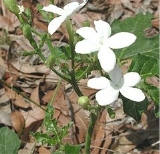
Spurge nettle
Encyclopedia
Spurge nettle also known as Tread-softly and Finger Rot, is a perennial
herb
covered with stinging hairs, native to southeastern North America
. A member of the family Euphorbiaceae
(spurge family), it is not a true nettle
. It prefers sandy, well-drained soil
and mostly exists in pine/blackjack oak
forests on sandhills, rims of Carolina bays, dunes, dry pastures, fields and roadsides.
The green leaves
of this plant are alternate, consisting of three to five untoothed lobes. The large, white flower
s have five petals. Male and female flowers are on different plants. Flowers occur throughout the spring and summer. The fruit
is a small capsule that produces three large, edible seeds. The seeds are very tasty when ripe and were much used by various Indian tribes. Though difficult to excavate except on side hills, the tap root can be used as an excellent potato substitute, tasting like pasta.
As the common names imply, the urticating hairs on this plant contain a caustic irritant that inflicts a painful sting to those who contact it with bare skin. It can cause a painful, irritating rash and can cause more serious reactions with some people.
The species name stimulosus comes from the Latin
stimul(us), meaning to "goad", "prod" or "urge". This plant is also known as Bullnettle and Mala mujer (Spanish
for "bad woman"), though the latter name is applied to several other plants with similar properties.
Perennial plant
A perennial plant or simply perennial is a plant that lives for more than two years. The term is often used to differentiate a plant from shorter lived annuals and biennials. The term is sometimes misused by commercial gardeners or horticulturalists to describe only herbaceous perennials...
herb
Herb
Except in botanical usage, an herb is "any plant with leaves, seeds, or flowers used for flavoring, food, medicine, or perfume" or "a part of such a plant as used in cooking"...
covered with stinging hairs, native to southeastern North America
North America
North America is a continent wholly within the Northern Hemisphere and almost wholly within the Western Hemisphere. It is also considered a northern subcontinent of the Americas...
. A member of the family Euphorbiaceae
Euphorbiaceae
Euphorbiaceae, the Spurge family are a large family of flowering plants with 300 genera and around 7,500 species. Most are herbs, but some, especially in the tropics, are also shrubs or trees. Some are succulent and resemble cacti....
(spurge family), it is not a true nettle
Nettle
Nettles constitute between 24 and 39 species of flowering plants of the genus Urtica in the family Urticaceae, with a cosmopolitan though mainly temperate distribution. They are mostly herbaceous perennial plants, but some are annual and a few are shrubby...
. It prefers sandy, well-drained soil
Soil
Soil is a natural body consisting of layers of mineral constituents of variable thicknesses, which differ from the parent materials in their morphological, physical, chemical, and mineralogical characteristics...
and mostly exists in pine/blackjack oak
Oak
An oak is a tree or shrub in the genus Quercus , of which about 600 species exist. "Oak" may also appear in the names of species in related genera, notably Lithocarpus...
forests on sandhills, rims of Carolina bays, dunes, dry pastures, fields and roadsides.
The green leaves
Leaf
A leaf is an organ of a vascular plant, as defined in botanical terms, and in particular in plant morphology. Foliage is a mass noun that refers to leaves as a feature of plants....
of this plant are alternate, consisting of three to five untoothed lobes. The large, white flower
Flower
A flower, sometimes known as a bloom or blossom, is the reproductive structure found in flowering plants . The biological function of a flower is to effect reproduction, usually by providing a mechanism for the union of sperm with eggs...
s have five petals. Male and female flowers are on different plants. Flowers occur throughout the spring and summer. The fruit
Fruit
In broad terms, a fruit is a structure of a plant that contains its seeds.The term has different meanings dependent on context. In non-technical usage, such as food preparation, fruit normally means the fleshy seed-associated structures of certain plants that are sweet and edible in the raw state,...
is a small capsule that produces three large, edible seeds. The seeds are very tasty when ripe and were much used by various Indian tribes. Though difficult to excavate except on side hills, the tap root can be used as an excellent potato substitute, tasting like pasta.
As the common names imply, the urticating hairs on this plant contain a caustic irritant that inflicts a painful sting to those who contact it with bare skin. It can cause a painful, irritating rash and can cause more serious reactions with some people.
The species name stimulosus comes from the Latin
Latin
Latin is an Italic language originally spoken in Latium and Ancient Rome. It, along with most European languages, is a descendant of the ancient Proto-Indo-European language. Although it is considered a dead language, a number of scholars and members of the Christian clergy speak it fluently, and...
stimul(us), meaning to "goad", "prod" or "urge". This plant is also known as Bullnettle and Mala mujer (Spanish
Spanish language
Spanish , also known as Castilian , is a Romance language in the Ibero-Romance group that evolved from several languages and dialects in central-northern Iberia around the 9th century and gradually spread with the expansion of the Kingdom of Castile into central and southern Iberia during the...
for "bad woman"), though the latter name is applied to several other plants with similar properties.
External links
- Cnidolscolus stimulosus - a site with plant information and excellent photographs.
- Tread-Softly Nettle

